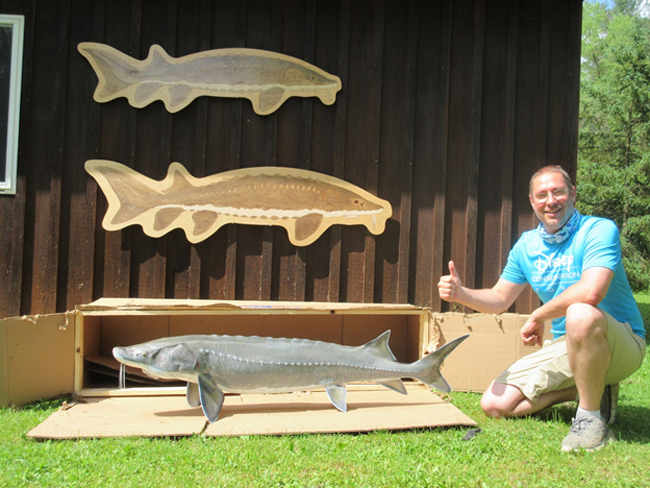Lake sturgeon are among the longest living fish in the world. The oldest lake sturgeon can live over 150 years! They are the largest fish that inhabit the lakes and rivers of the Great Lakes region. Lake sturgeon are considered “living fossils” because their appearance has not changed for millions of years.
They weigh over 300 pounds and reach lengths of 8 feet! They have 5 rows of bony plates (scutes). Like sharks, lake sturgeon skeletons are primarily made of cartilage and they have a non-symmetrical (heterocercal) tail. They have 4 whiskers (barbels), like catfish for finding food. Lake sturgeon have no teeth, but they capture prey like mussels, snails, invertebrates and prey fish with their vacuum-like mouth that extends downward (protrusible) when feeding on the bottom.
Pictured at top of page: Juvenile lake sturgeon prior to being stocked into the Lake Ontario watershed where it may survive to be over 100 years old! Credit: Jesse Lepak, NYSG.
Lake sturgeon were once very abundant, but by the early 1900’s, there were few left due to habitat degradation (for example, dams that blocked lake sturgeon from their spawning grounds) and overfishing. Lake sturgeon were listed as threatened in New York State in 1983. Ten years later a stocking program began, and now about 10,000 lake sturgeon are stocked every year in New York to maintain and enhance populations.
In Fall 2018, New York Sea Grant (NYSG) began an outreach project to support lake sturgeon recovery efforts in New York, for which the program would lead outreach and education programs to inspire appreciation for this prehistoric freshwater fish and state Threatened Species.
Here are some outreach materials created during this project ...
PUBLICATIONS
Lake Sturgeon: Fact Sheet | PDF
Lake Sturgeon: Tip Sheet | PDF
Lake Sturgeon: Intermediate Curriculum | PDF
(Also see related Press Release)
— For Other New York Sea Grant Curricula and Teaching Resources: see GLEEE's Great Lakes Curriculum page
— For Other New York Sea Grant Fisheries Resources: nyseagrant.org/glsportfish
VIDEOS
Lake Sturgeon: NYSG's Spotlight on a Species in Need
VIDEOS: Lake Sturgeon: NYSG's Spotlight on a Species in Need — The video above highlights: 1) Lake Sturgeon Population Decline, 2) Challenges, 3) Life Cycle, 4) Conservation, and 5) Research; the 6) Lake Sturgeon Restoration video below notes the annual stocking of the fish into New York waters and reminds anglers to immediate release a lake sturgeon if caught in New York waters.
In the spotlight in this seven-and-a-half-minute video is lake sturgeon.
The video above was produced and narrated by New York Sea Grant's former Fisheries and Ecosystem Specialist Jesse Lepak and supported in part through a grant from the Disney Conservation Fund
Here are some facts about lake sturgeon that are mentioned in the video:
- The lake sturgeon is one of New York's largest freshwater fish.
- They are the longest-living fish in the world. Although male Lake Sturgeon can live to be 55 years old and females to 80, the oldest lake sturgeon lived over 150 years.
- Lake sturgeon were once very abundant, but by the early 1900’s, there were few left due to habitat degradation and overharvesting primarily for eggs.
- Mature adults average between 3-5 feet in length and 10-80 pounds in weight, but can occasionally grow as large as 7+ feet and 300+ pounds.
- Lake Sturgeon are one of the few species that can eat invasive Zebra & Quagga Mussels.
- Approximately 10,000 Lake Sturgeon are stocked every year in New York to maintain and enhance populations.
Lake Sturgeon Restoration
Transcript: The Lake Sturgeon was once abundant in New York.
But this species was overharvested and its spawning grounds were blocked off and degraded.
Currently, Lake Sturgeon are threatened in New York, and about 10 to 11,000 are stocked each year throughout the state to help support the now recovering populations.
These small fish could one day grow to 8 feet long, and over 200 pounds and the oldest Lake Sturgeon can live for over 150 years.
If you see a Lake Sturgeon, keep your distance, and do not disturb them, and immediately release a sturgeon if you ever happen to catch one in New York.
Lets keep these fish happy and healthy for generations to come.
OTHER EDUCATIONAL MATERIALS

This Lake Sturgeon replica will join others already being used by project partners such as New York Sturgeon for Tomorrow and the Aquarium of Niagara during outreach events to promote Lake Sturgeon conservation. Credit: Jesse Lepak/NYSG.
More Info: New York Sea Grant
New York Sea Grant (NYSG), a cooperative program of Cornell University
and the State University of New York (SUNY), is one of 34 university-based
programs under the National Oceanic and Atmospheric Administration’s
National Sea Grant College Program.
Since 1971, NYSG has represented a statewide network of integrated
research, education and extension services promoting coastal community
economic vitality, environmental sustainability and citizen awareness
and understanding about the State’s marine and Great Lakes resources.
Through NYSG’s efforts, the combined talents of university scientists
and extension specialists help develop and transfer science-based
information to many coastal user groups—businesses and industries,
federal, state and local government decision-makers and agency managers,
educators, the media and the interested public.
The program maintains Great Lakes offices at Cornell University, SUNY
Buffalo, SUNY Oswego and the Wayne County Cooperative Extension office
in Newark. In the State's marine waters, NYSG has offices at Stony Brook
University in Long Island, Brooklyn College and Cornell Cooperative
Extension in NYC and Kingston in the Hudson Valley.
For updates on Sea Grant activities: www.nyseagrant.org has RSS, Facebook, Twitter, Instagram, and YouTube links. NYSG offers a free e-list sign up via www.nyseagrant.org/nycoastlines for its flagship publication, NY Coastlines/Currents, which is published quarterly. Our program also produces an occasional e-newsletter,"NOAA Sea Grant's Social Media Review," via its blog, www.nyseagrant.org/blog.